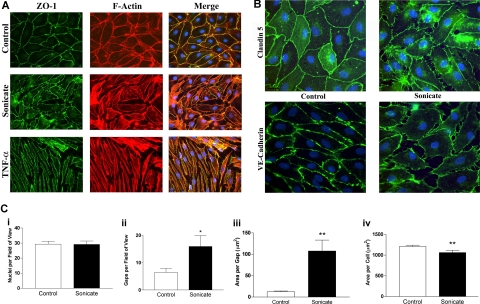Figure 2.
Morphologic changes in tight and adherens junctions proteins induced by P falciparumsonicates in HDMECs. HDMECs (105) were seeded on gelatin-coated glass coverslips of surface area 1 cm2 and incubated until 3 days after confluence. Parasite sonicates were added at 107 parasite equivalents/cm2 as for transwell assays. At the end of 24 hours, coverslips were washed in HBSS and fixed in 1% paraformaldehyde at 4°C for 30 minutes. Coverslips for staining of ZO-1 and F-actin were permeabilized with 0.5% Triton X-100. For detection of VE-cadherin, fixed cells were permeabilized with 100% methanol. (A) Staining for the tight junction protein ZO-1 (green) and F-Actin (red). In control monolayers, staining was continuous with occasional gap formation. ZO-1 colocalized with the F-actin cytoskeleton. In monolayers incubated with parasite sonicates, there was discontinuous staining of ZO-1 and increased gap formation. The overlay shows increased cytosolic ZO-1 staining as well as loss of association of ZO-1 with the F-actin cytoskeleton. These changes differed from the extensive stress fiber formation and cell contraction seen in TNF-α–stimulated monolayers. (B) Discontinuous staining of the tight junction protein claudin 5 and adherens junction protein VE-cadherin following incubation with parasite sonicates. Results in panels A and B are representative of 3 independent experiments. (C) Quantitation of morphologic changes shown in panel A by ImageJ software (n = 6). (i) Number of viable nuclei per field of view. (ii) Number of gaps between adjacent endothelial cells. (iii) Size of area per gap. (iv) Surface area of each endothelial cell. *P < .05, **P < .01 compared with control values by Student paired t test. (C) Results are expressed as mean (± SD).

